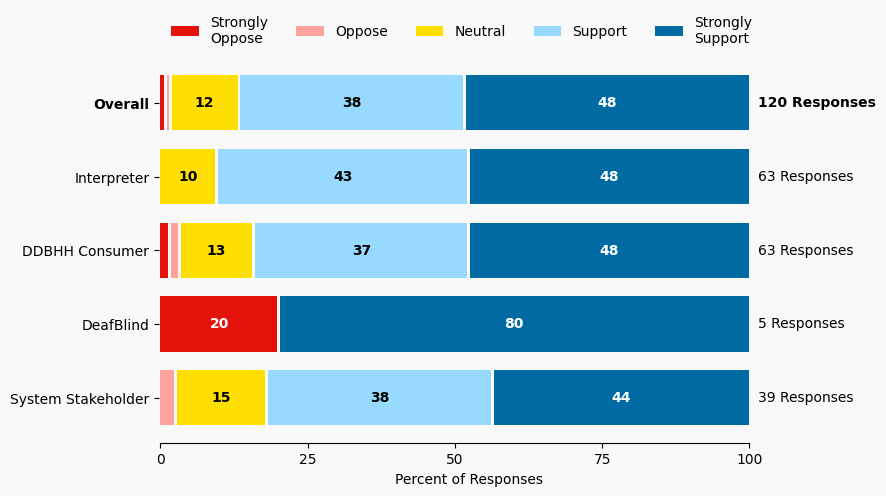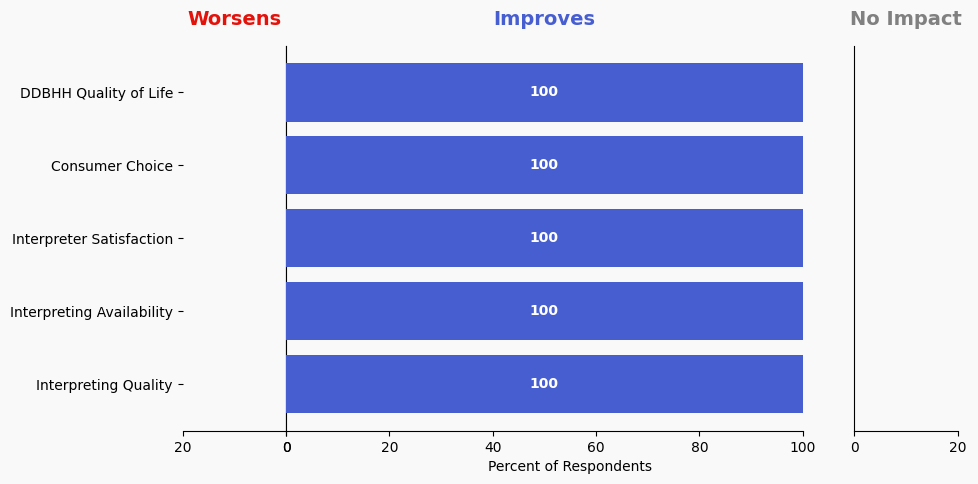54 Educate DeafBlind Youth in ProTactile
Issue: DeafBlind youth will benefit from accessing ProTactile but the information is not currently being shared with students and families
Proposed Solution: Department of Education (Minnesota DeafBlind Project), the Commission and DeafBlind partner organizations create opportunities for DeafBlind youth in schools to learn and practice Pro-Tactile communication.
Expected outcome: DeafBlind persons experiencing greater communication and contextual information from an earlier age are more likely to be autonomous and experience better educational outcomes with greater access to information.
Who is impacted: Primarily DeafBlind youth, parents, school districts
Timeline: 6 months
Note: Metro Deaf School and Minnesota State Academies for the Deaf and Blind would be critical partners to advise on already existing programs and opportunities for DeafBlind youth

Summary of Support Image Description
The stacked bar charts show how respondents rated their level of support and the total number of responses. The percentage for the five support levels is shown from left to right: Strongly Oppose (Dark Red), Oppose (Light Red), Neutral (Yellow), Support (Light Blue), and Strongly Support (Dark Blue).
Respondents may identify with multiple subgroups. The overall level of support is:
Overall
Strongly Oppose: 1%
Oppose: 1%
Neutral: 12%
Support: 38%
Strongly Support: 48%
Click to see the detailed image description for each subgroup.
Interpreter
Strongly Oppose: 0%
Oppose: 0%
Neutral: 10%
Support: 43%
Strongly Support: 48%
DeafBlind
Strongly Oppose: 20%
Oppose: 0%
Neutral: 0%
Support: 0%
Strongly Support: 80%
DDBHH Consumer
Strongly Oppose: 2%
Oppose: 2%
Neutral: 13%
Support: 37%
Strongly Support: 48%
System Stakeholder
Strongly Oppose: 0%
Oppose: 3%
Neutral: 15%
Support: 38%
Strongly Support: 44%
Overview of Respondents Opting for In-Depth Solution Analysis
After indicating their support level, 3% of the 120 respondents opted in to further assess whether the solution would worsen or improve on five metrics. Of the opt-in reviewers (4 respondents), 75% supported the solution, 25% were neutral on the solution, and 0% opposed the solution.
The remaining 116 respondents did not opt in to further assess the solution. Of these people, 87% support the solution, 11% were neutral on the solution, and 1% opposed the solution.
Reviewer Evaluation of Solution Effectiveness

Solution Effectiveness Image Description
The stacked bar charts show how respondents assessed the effectiveness of this solution based on five metrics. For each metric, the percentage of respondents is shown from left to right: Worsens (Red), Improves (Blue), No Impact (Gray).
DDBHH Quality of Life
Makes It Worse 0%
Makes It Better 100%
No Impact 0%
Interpreter Satisfaction
Makes It Worse 0%
Makes It Better 100%
No Impact 0%
Consumer Choice
Makes It Worse 0%
Makes It Better 100%
No Impact 0%
Interpreting Availability
Makes It Worse 0%
Makes It Better 100%
No Impact 0%
Interpreting Quality
Makes It Worse 0%
Makes It Better 100%
No Impact 0%
Reviewer Feedback and Insights
Interpreter
Comments from Interpreters support the idea of educating DeafBlind youth in ProTactile communication, emphasizing the need for early education and involvement of local institutions and organizations.
Deaf, DeafBlind, Hard of Hearing
Comments from DDBHH Consumers emphasize the importance of teaching effective communication methods from a young age and support the education of DeafBlind youth in ProTactile. Comments also suggest focusing on educational interpreters and ensuring the philosophy of ProTactile modalities is incorporated into their training.
System Stakeholder
Comments from System stakeholders express support for involving local schools and organizations in implementing this educational initiative.
PREVIOUS SOLUTION
53 Pursue Legislation for DeafBlind Students in K12 Education
Issue: DeafBlind youth, parents, education systems
NEXT SOLUTION
55 Educate Health Care Systems on the Need for On-Site Interpreters
Issue: Decision makers in health care settings make decisions that negatively impact the deaf, deafblind and hard of hearing community and interpreters.
Leave a Reply